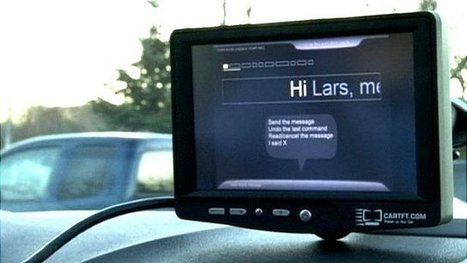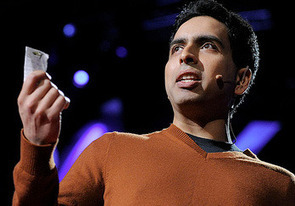 Your new post is loading...
 Your new post is loading...

|
Scooped by
Mel Riddile
January 5, 2012 3:05 PM
|
Redefining “Cheating” With Homework
"Technology is often blamed for encouraging bad behavior, particularly when it comes to academic dishonesty. There’s the notion, for example, that it’s much easier to plagiarize now thanks to the ability to copy and paste information from the Web into a term paper.
So at first blush, the new homework help Web site Slader might be accused of fostering just this sort of cheating behavior. The site offers the answers to homework questions in most major high school level math textbooks, and depending on how much you use it, there’s a fee. Students can pay for answers. Answers to all the questions, not just the odd ones. And answers with explanations and “proofs.” But it’s not as straightforward a transaction as it looks."

|
Scooped by
Mel Riddile
January 4, 2012 6:10 PM
|
Teachers in Idaho and elsewhere have been in revolt over policy makers thrusting technology into classrooms and shifting money to unproven teaching methods.

|
Scooped by
Mel Riddile
January 4, 2012 5:43 PM
|
From Yahoo!:
Experts Ask: Are Kids Meaner or Do They Lack Education to Use Technology Tools?
Do a quick search on YouTube and find dozens of videos of teachers "flipping out" to the jeering laughter of students -- a music teacher smashes a violin, another spits on a student in full classroom meltdown.
21% of teachers
Recently the cyber security company Norton reported that 21 percent of teachers worldwide either experienced cyberbaiting themselves or knew a colleague who was cyberbaited. Many lose their jobs after their outbursts, even though students were the provocateurs.
So far, according the Norton study, only 51 percent of teachers said their schools had guidelines for social media communication.
Bullying
In this form of bullying, known as cyberbaiting, students provoke the teacher to the breaking point, then secretly record the tantrum on a cell phone, then post it online. Not only is it humiliating, demolishing a teacher's morale, but it can cost them their job.

|
Rescooped by
Mel Riddile
from "iPads, STEM and Making"
January 3, 2012 11:39 AM
|

|
Scooped by
Mel Riddile
January 2, 2012 12:52 PM
|
The Maya said we're due for a shake-up soon. Turns out, they were right.
2014 - A 1 Terabyte SD Memory Card probably seems like an impossibly unnecessary technological investment. Many computers still don’t come with that much memory, much less SD memory cards that fit in your digital camera. Yet thanks to Moore’s Law we can expect that the 1TB SD card will become commonplace in 2014, and increasingly necessary given the much larger swaths of data and information that we’re constantly exchanging every day (thanks to technologies like memristors and our increasing ever-connectedness). The only disruptive factor here could be the rise of cloud-computing, but as data and transfer speeds continue to rise, it’s inevitable that we’ll need a physical place to store our digital stuff.
- The first around-the-world flight by a solar-powered plane will be accomplished by now, bringing truly clean energy to air transportation for the first time. Consumer models are still far down the road, but you don’t need to let your imagination wander too far to figure out that this is definitely a game-changer. Consider this: it took humans quite a few milennia to figure out how to fly; and only a fraction of that time to do it with solar power.

|
Scooped by
Mel Riddile
December 28, 2011 6:24 PM
|
Social media has evolved rapidly and we have seen the emergence of new social networks.Surprises this year included the launch of Google+ (which acquired 25 million users in less than 30 days), Pinterest which grew at more than 512% and Tumblr (the...

|
Scooped by
Mel Riddile
December 28, 2011 5:48 PM
|
Are you ready to bring social networking to your classroom? If you’re looking to make your classroom more relevant, connected, and meaningful to your students, it’s the best place to start. Study after study has confirmed the benefits of networking.
Twitter – If you have a personal account, create a second one for connecting with your students. They want to follow classroom updates not what you’re having for dinner or what time the revolution begins (if you’re leading one of those in your personal time). Twitter will be your social media workhorse. Use it to push out calendar notices, classroom tips, celebrations, links, polls, and the occasional personal message to remind followers you’re a human and not a bot. Encourage parents to follow, too. Twitter is also great in the classroom, and I mean, literally, in the classroom. Use if for quick formative assessments. Students who use Twitter to contribute to class discussion more than double their class contributions. Lastly, create a unique Twitter hashtag just for your classroom. Get input on the hashtag creation from your new social media army that’s following you.

|
Scooped by
Mel Riddile
December 20, 2011 3:33 PM
|
Apple's Siri software has given consumers a renewed interest in voice technology. The BBC's Ian Hardy takes an exclusive look at the latest innovations.
Good (90% accuracy) and Getting Better
But the past couple of years have seen startling improvements. Accuracy in many applications is now in the mid to upper nineties percentage wise. There are two developments that may accelerate research in the near future.
The more we talk the more accurate it gets!
Mobile apps provide the company with a rich source of new speech data to work with.
Firstly, mobile apps like Dragon Go and Siri, which have only appeared recently, are providing Nuance with a huge new data stream to study.
Every time you talk into your device, your words are uploaded and stored on servers. This means Nuance can analyze intonation, accents and languages in minute detail and constantly improve recognition algorithms.
Secondly people are becoming more used to speaking "correctly" to their phones and web browsers. They discover over time that specific phrases, background noise and pace all play a part in the success of a spoken inquiry.

|
Scooped by
Mel Riddile
December 19, 2011 4:21 PM
|
Rather than turn our noses up at Twitter, we should celebrate it and the internet as new platforms for instant communication and as drivers of literacy, says CanLit legend Margaret Atwood.

|
Scooped by
Mel Riddile
December 15, 2011 3:53 PM
|
NSBA press release - Center for Public Education Most U.S. schools require at least as much or more instructional time as other countries, even high-performing countries like Finland, Japan, and Korea; according to a new report on instructional time released by the National School Boards Association's Center for Public Education. The report, "Time in School," measured the minimum number of hours of instruction per year (also known as compulsory hours) countries require their public schools to provide in a formal classroom setting. In the U.S., most states require between 175 and 180 days of school and/or between 900 and 1,000 hours of instructional time per year, depending on the grade level. "Providing additional time can be an effective tool for improving student outcomes, but how that time is used is most important." -- JimHull, Center for Public Education

|
Scooped by
Mel Riddile
December 15, 2011 2:42 PM
|
These educators are being recognized for their ability to inspire others to use technology effectively to improve the K-12 experience. (RT @mcleod: Nominate someone for NSBA's "20 to Watch" program. Honor emerging, impactful #edtech leaders.

|
Scooped by
Mel Riddile
December 13, 2011 3:53 PM
|
If we want to encourage our teachers to become paperless and use the copier less, then as school leaders we need to take the lead and engage in becoming paperless too. 1. Google Docs 2. Email 3. Dropbox 4. Evernote 5. Diigo 6. Skype / Google Talk 7. Blogger

|
Scooped by
Mel Riddile
December 5, 2011 9:01 AM
|
Social media sites are blocked in Springfield IL schools. For now. Thanks to a progressive new approach to social media, the district is consulting with teachers and administrators to figure out the best way to use social media.
|

|
Scooped by
Mel Riddile
January 5, 2012 2:57 PM
|
The Document Camera
This guy has gone the way of the overhead machine. With the iPad2 and the Apple TV, there is nothing the Document Camera brings to the table. He sits at my desk with his head hanging down in disgrace. His stationary existence just doesn’t fit in with this mobile world. He was the most popular kid in my class for a couple of years, but now he is just another obsolete tool. I’m sure I can find a home for DC. Hopefully.

|
Scooped by
Mel Riddile
January 4, 2012 5:46 PM
|
The Disney Mobile Cell and Tell survey of more than 1,500 10-17 year-old cell phone users found that teens and tweens like their cell phones perhaps more than other luxuries in their lives.
“If they had to choose between their phone or something else:
● One-third would give up listening to the radio, playing video games or going to the mall.
● Nearly one-fourth would give up their MP3 players.
● One in five would give up TV” (2007)
Willyn Webb brings you 12 Most Useful Ways Kids Can Learn With Cell Phones...

|
Rescooped by
Mel Riddile
from Tools for Teachers & Learners
January 3, 2012 12:11 PM
|
This is a very impressive free app for iPhone etc which enhances any videos you create on your mobile device. It's a little like the Instagram of video. Really useful to enhance your videos.
Via Nik Peachey

|
Scooped by
Mel Riddile
January 3, 2012 11:24 AM
|
First, What’s A Hashtag? The # symbol, called a hashtag, is used to mark keyword or topic in a Tweet. Any Twitter user can categorize or follow topics with hashtags.Those hashtags (usually) mean something and are a great way to get a tweet to appear in search results or discussion monitoring.
For example, the popular #edchat hashtag is used by thousands of users every Tuesday. It makes it easy (sort of) for people to monitor what’s happening in the conversation rather than having to try and guess what topics you should search for. By having a conversation on Twitter using hashtags, you also make it easy for any other Twitter user to join in.
How To Hide Your Hashtag Chat From Followers
When having a Twitter #hashtag chat, if you want to avoid overwhelming your followers, start any tweet you want to “hide” with @HideChat or (one character shorter) @HideTag. (Do NOT follow @HideChat or @HideTag. They exist only to help you hide your Twitter chats.) NOTE: This also works when live-tweeting events or shows.
You don’t need to do this with all your chat tweets (though you could). But it’s a good idea to do it with most of them so as not to overwhelm folks. You could also use this for conversations with someone that you didn’t want others to notice in your timeline, although direct messages would work best for that.

|
Scooped by
Mel Riddile
January 2, 2012 12:43 PM
|
I will... - link to others generously,
- retweet great ideas and give credit to original thinkers,
- mention people by name when they give me ideas, whatever the source may be,
- work to promote the work of others who support the cause of teaching, reaching, (and loving) every child,
- respect each person as an original,
- extend my hand of fellowship and friendship,
- be the Internet I want my children to inherit,
- be kind to others even when they don't deserve it,
- stand up for the right thing even when it means I will be ridiculed for it, (All it takes is for good people to be quiet for horrible things to happen.)
- discover and share new voices with the spotlight gifted to me by readers and friends,
- be passionate to speak for those who do not have a voice: those in slavery, the poor, those separated by the digital divide, and
- listen to you when you speak and seek discernment about what to do with what you say.

|
Scooped by
Mel Riddile
December 28, 2011 6:19 PM
|
December 28, 2011
Key Takeaways - Khan Academy is now seeing an incredible 4 million unique users per month. That’s up from 1 million in the same period last year, and up from 3.5 million in October. Think Edudemic will hit that mark?
- Thanks to the AMA, Khan may team up with Michael Nielsen to help the world get a better understanding of quantum computation.
- Khan is a big fan (and graduate) of MIT and MITx. He thinks it’s the future of education. More on that below in the questions.
- The Khan Academy team is currently 22 people strong and they’re hiring ~1 more per month.

|
Scooped by
Mel Riddile
December 20, 2011 3:37 PM
|
Thanks to Susan Murphy of Algonquin College (check out her awesome blog suzemuse.com!), we have our answers. She was kind enough to answer some of my questions about her experiences flipping her classroom.
She used the flipped classroom model for her First Year Video and Audio Production class which is part of the Interactive Multimedia Developer program. The course was this past Fall and ran from September to December. What follows is my interview with Susan. Enjoy!
What inspired you to use the flipped classroom model?
I first learned about flipped classrooms by watching Salman Khan’s remarkable TED Talk about how he started the Khan Academy (embedded below). I was completely inspired, and eager to try this new model out in my own classroom.
More...

|
Scooped by
Mel Riddile
December 19, 2011 4:22 PM
|
While Twitter doesn't have a written set of social guidelines (excepting its Terms of Service, of course), it does have a pretty well established set of unwritten guidelines that users should observe. Here's a few things you might want to consider when tweeting. Don't DM Me, I'll DM You

|
Scooped by
Mel Riddile
December 19, 2011 12:51 PM
|
School districts across the country are imposing strict new guidelines that ban private conversations between teachers and their students on cellphones and online platforms. Most Use Social Media Appropriately School administrators acknowledge that the vast majority of teachers use social media appropriately. But they also say they are increasingly finding compelling reasons to limit teacher-student contact. 12 States Have Updated Social Media Policies School boards in California, Florida, Georgia, Illinois, Maryland, Michigan, Missouri, New Jersey, Ohio, Pennsylvania, Texas and Virginia have updated or are revising their social media policies this fall. A Middle Ground “My concern is that it makes it very easy for teachers to form intimate and boundary-crossing relationships with students,” said Charol Shakeshaft, chairwoman of the Department of Educational Leadership at Virginia Commonwealth University, who has studied sexual misconduct by teachers for 15 years. “I am all for using this technology. Some school districts have tried to ban it entirely. I am against that. But I think there’s a middle ground that would allow teachers to take advantage of the electronic technology and keep kids safe.” Teacher Perspective “I think the reason why I use social media is the same reason everyone else uses it: it works,” said Jennifer Pust, head of the English department at Santa Monica High School, where a nonfraternization policy governs both online and offline relationships with students. “I am glad that it is not more restrictive. I understand we need to keep kids safe. I think that we would do more good keeping kids safe by teaching them how to use these tools and navigate this online world rather than locking it down and pretending that it is not in our realm.” Nicholas Provenzano, 32, who has been teaching English for 10 years at Grosse Point High School in Michigan, acknowledged that “all of us using social media in a positive way with kids have to take 15 steps back whenever there is an incident.” But he said the benefits were many and that he communicated regularly with his students in an open forum, mostly through Twitter, responding to their questions about assignments. He has even shared a photo of his 6-month-old son. On occasion, he said, he will exchange private messages about an assignment or school-related task. He said that in addition to modeling best practices on social media use, he has been able to engage some students on Twitter who would not raise their hand in class. He also said social media networks allowed him to collaborate on projects in other parts of the country. Facebook offers guidance for teachers and recommends they communicate on a public page.

|
Scooped by
Mel Riddile
December 15, 2011 3:05 PM
|
The Hilliard City School District is taking some innovative approaches to reach students, including flipping the classroom. The "Flipped Classroom" Defined In a traditional classroom, a teacher gives the lesson and assigns homework to be done outside of class. But in a flipped classroom, the student watches a video of the teacher giving the lesson at his or her convenience. The next day in class, students work together in groups on the homework, and the teacher answers any questions. “Sometimes in math, students won’t do their homework or finish it because they get stuck, so we thought about flipping the classroom.” Teachers digitally record lessons that students can watch through the district’s eCampus website. “We’re cutting a 35-minute lecture down to about 15 minutes, because that’s the attention span of kids these days,” Tsai said. “They do them outside of the classroom, at home, on the computer in the library or even a smart device. You can take notes, pause, rewind, replay any concepts they’ve missed, they can go back with the click of a button.” Review and Practice The online materials also allow a student to practice any topic in math. “If you get 10 in a row (correct), it tells you to move on. You’ve mastered it,” Tsai said. Students Like Personalized Attention Caitlin Busic, a junior, said of the flipped math class, “It’s helped me a lot because I got more personalized attention. I can work independently to learn it.” Another class, Spanish, is also being transformed by technology. Darby Spanish teacher Brian Linn said that on his eCampus site, he has his own digital avatar (a cartoon figure that represents him), and has students use animated characters to speak in Spanish on their assignments. Formative Assessments and Practice Retrieval The students also use Quizlet.com, a site that provides flash cards that can be accessed on smart phones and tablets. Linn said teachers can quickly generate tests by using Quizlet, too. “You can see that these places exist. It helped me to connect to what I was learning.” Community of Practice McClure said his teachers frequently discuss new apps that are available for devices and how they can be applied to project-based, 21st century learning. Application and Mastery “There’s no reason to memorize anything, you can find everything so quickly (online),” McClure said. “They really deal in concepts and applications so much differently. The technology part is what the kids can do, and how quickly they can do it is really pretty neat.” Paperless Another thing you won’t see in some classrooms is paper, McClure said. “To pay for a lot of the technology and to put it in the kids’ hands, each of the last three years we have made very significant cuts in department budgets for paper, and it’s a much better experience for the kids.” A Device for Every Student? What about students who don’t own a home computer, smart phone or iPad? “Our media center has computers available all day long,” McClure said. “We have a lot of kids that go to the public library, work together, stop at mom and dad’s work place and use the computer. The vast majority of our kids have access. They’re finding a way.”

|
Scooped by
Mel Riddile
December 15, 2011 12:05 PM
|
At the same time that school filters prevent access to social media sites, high schools are beginning to offer courses in social media marketing. Salt Lake City, UT (PRWEB) December 15, 2011 The views some high school and college students have of social media may be changing as they break this month for the holidays. Before Davis High School junior Breanna Barton took Jeff McCauley's new social media marketing class, Facebook and YouTube were merely means for wasting time. Now Barton sees things a little differently. SEO.com is hiring some of these graduates as growth rates in social media marketing are expected to increase about 33 percent each year, from $400 million in 2010 to $2.3 billion in 2015, according to a forecast by BIA/Kelsey. Read more: http://www.sfgate.com/cgi-bin/article.cgi?f=/g/a/2011/12/15/prweb9034712.DTL#ixzz1gcjKlNej

|
Scooped by
Mel Riddile
December 10, 2011 2:59 PM
|
To produce a stimulating 21st-century learning environment, school leaders see educational technology as a no-brainer. New guidelines for vendors and educators aim to solve this comparison conundrum. The report, titled “Conducting and Reporting Product Evaluation Research: Guidelines and Considerations for Educational Technology Publishers and Developers,” is authored by Denis Newman, CEO of Empirical Education Inc., and produced by the Software & Information Industry Association (SIIA). It’s based on Empirical Education’s many years of conducting this kind of research, both for publishers and for the U.S. Department of Education (ED). A working group of industry experts also was established for evaluation, and it met monthly for more than a year to sort through the issues and draft a set of considerations. The guidelines, available free of charge on SIIA’s website, are timely for educators and ed-tech providers because of the growing demand from schools for “evidence of effectiveness of products, especially as the resources for spending on program materials decreases and administrators have to make harder decisions about what will best solve the problems facing their districts,” said Newman in an interview with eSchool News. He added that ED, through programs such as Investing in Innovation (i3), is showing a growing interest in gathering evidence of effectiveness, and this is also reflected in the draft reauthorization of the Elementary and Secondary Education Act, which talks consistently of evidence-based programs. Evidenced-Based “By evidence-based, they mean having evidence of the sort the guidelines help publishers and school district administrators obtain,” said Newman. “The guidelines are written in a style that can be understood by executives, whether they work for publishers or for school districts. District executives will find them useful not only to get clear on what they can and should expect from publishers, but because it can help them see how their own data can be used to evaluate programs they’ve already put in place and are considering expanding.”
|



 Your new post is loading...
Your new post is loading...



















![How the Flipped Classroom Really Works [Interview] | Edudemic | TechTalk | Scoop.it](https://img.scoop.it/rb3lweD2ssq47mVrXdwaCDl72eJkfbmt4t8yenImKBVvK0kTmF0xjctABnaLJIm9)











